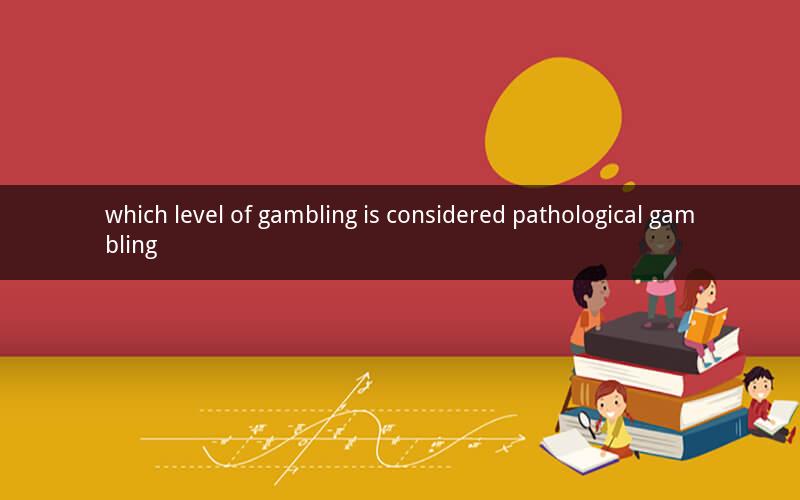
Table of Contents
1. Introduction to Pathological Gambling
2. Defining Pathological Gambling
3. Levels of Pathological Gambling
3.1 Mild Pathological Gambling
3.2 Moderate Pathological Gambling
3.3 Severe Pathological Gambling
4. Factors Influencing Pathological Gambling Levels
5. Diagnosis and Treatment
6. Conclusion
1. Introduction to Pathological Gambling
Gambling has been a part of human culture for centuries, offering entertainment and a way to earn money. However, when gambling becomes uncontrollable and begins to negatively impact an individual's life, it can lead to pathological gambling. Understanding the different levels of pathological gambling is crucial in identifying and addressing this issue effectively.
2. Defining Pathological Gambling
Pathological gambling, also known as gambling disorder, is a mental health condition characterized by an inability to control gambling behavior, leading to significant distress and impairment in personal, professional, or social functioning. The individual may continue to gamble despite knowing the negative consequences.
3. Levels of Pathological Gambling
The severity of pathological gambling can vary, and it is important to recognize the different levels to provide appropriate intervention.
3.1 Mild Pathological Gambling
Mild pathological gambling is characterized by occasional gambling that does not significantly disrupt the individual's life. However, the individual may experience some tension or stress when not gambling. They may also have a few unsuccessful attempts to control their gambling behavior.
3.2 Moderate Pathological Gambling
Moderate pathological gambling involves more frequent gambling and a higher level of tension or stress when not gambling. The individual may experience some financial, social, or occupational problems due to their gambling. They may also have more unsuccessful attempts to control their gambling behavior.
3.3 Severe Pathological Gambling
Severe pathological gambling is characterized by frequent and intense gambling, leading to significant distress and impairment in various aspects of life. The individual may experience severe financial, social, and occupational problems, and they may have multiple unsuccessful attempts to control their gambling behavior.
4. Factors Influencing Pathological Gambling Levels
Several factors can influence the level of pathological gambling, including:
- Genetic predisposition: Some individuals may have a genetic predisposition to develop gambling problems.
- Environmental factors: Exposure to gambling opportunities, peer pressure, and cultural attitudes towards gambling can influence the development of gambling problems.
- Psychological factors: Stress, anxiety, and depression can contribute to the development of gambling problems.
- Lifestyle factors: Financial difficulties, unemployment, and social isolation can exacerbate gambling problems.
5. Diagnosis and Treatment
Diagnosing pathological gambling involves assessing the individual's gambling behavior and its impact on their life. Treatment options may include:
- Cognitive-behavioral therapy (CBT): This type of therapy helps individuals develop coping strategies and address the underlying psychological factors contributing to their gambling problems.
- Medication: Certain medications may be prescribed to help manage symptoms of anxiety or depression associated with gambling problems.
- Support groups: Joining a support group can provide individuals with a sense of community and support from others who have experienced similar challenges.
- Outpatient or inpatient treatment: Depending on the severity of the gambling problem, individuals may benefit from outpatient or inpatient treatment programs.
6. Conclusion
Understanding the different levels of pathological gambling is essential for early detection and intervention. By recognizing the signs and symptoms of gambling problems, individuals can seek help and take steps to regain control of their lives.
Questions and Answers
1. Q: What is the difference between problem gambling and pathological gambling?
A: Problem gambling refers to any gambling behavior that causes distress or harm, while pathological gambling is a severe form of problem gambling characterized by an inability to control gambling behavior.
2. Q: Can pathological gambling be cured?
A: While there is no cure for pathological gambling, it can be effectively managed with appropriate treatment and support.
3. Q: Are there any genetic factors that contribute to pathological gambling?
A: Yes, some research suggests that there may be a genetic predisposition to developing gambling problems.
4. Q: Can stress or anxiety lead to pathological gambling?
A: Yes, stress and anxiety can contribute to the development of gambling problems, as individuals may turn to gambling as a coping mechanism.
5. Q: What is the most effective treatment for pathological gambling?
A: The most effective treatment for pathological gambling often involves a combination of cognitive-behavioral therapy, medication, support groups, and lifestyle changes.
6. Q: Can pathological gambling affect relationships?
A: Yes, pathological gambling can have a significant impact on relationships, leading to conflict, trust issues, and emotional distress.
7. Q: Is it possible to prevent pathological gambling?
A: While there is no guaranteed way to prevent pathological gambling, individuals can take steps to reduce their risk, such as avoiding gambling opportunities and seeking support when needed.
8. Q: Can children develop pathological gambling?
A: Yes, children can develop gambling problems, although it is less common than in adults.
9. Q: Are there any legal consequences for pathological gambling?
A: In some cases, individuals with pathological gambling may face legal consequences, such as financial fraud or theft, due to their gambling behavior.
10. Q: Can pathological gambling lead to addiction?
A: Yes, pathological gambling is considered a form of addiction, as it involves compulsive behavior and can lead to significant harm.